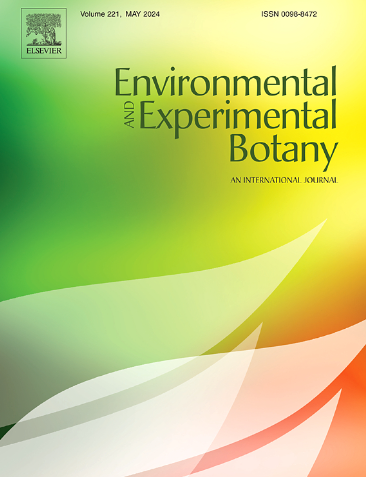铜绿微囊藻分泌物通过影响植物激素积累和生长素信号转导来改变根系发育
IF 4.7
2区 生物学
Q2 ENVIRONMENTAL SCIENCES
引用次数: 0
摘要
铜绿微囊藻是一种典型的蓝藻,可以改变水生植物的根系发育。为了探究M. aeruginosa对植物根系发育的影响,我们将拟南芥暴露于M. aeruginosa exudate (MaE)环境中,研究了其对植物激素合成和生长素信号转导的响应。结果表明,MaE显著促进侧根原基发育,增加侧根数量,缩短主根长度。在MaE处理第7天,拟南芥总根中细胞分裂素水平下降,这与第5天和第7天细胞分裂素合成和代谢基因表达下降一致。致病菌防御激素水杨酸(SA)和N-(茉莉酸)- s -JA-Ile(JA-Ile)浓度显著升高,但其合成和代谢基因表达水平下调。同样,虽然根系中生长素类化合物的浓度差异不显著,但其合成和代谢基因表达水平下调。在生长素信号转导通路中,MaE与对照组之间的生长素信号输入保持不变,这可以从DII的表达水平看出,而MaE放大了生长素信号输出,这可以从DR5的表达水平看出。调控侧根发育的转录因子ARF7在生长素信号转导通路的下游被MaE显著激活。这些结果表明,MaE通过改变植物激素平衡和生长素信号转导影响植物根系结构。本文章由计算机程序翻译,如有差异,请以英文原文为准。
Microcystis aeruginosa exudate alters root development by impacting plant hormone accumulation and auxin signal transduction
Microcystis aeruginosa, a typical cyanobacterial species, can alter the root development of aquatic plants. To explore how M. aeruginosa affects plant root development, we exposed Arabidopsis thaliana to M. aeruginosa exudate (MaE) and investigated the responses of plant hormone synthesis and auxin signal transduction. Results showed that MaE significantly advanced lateral root primordium development, increased lateral root number, and reduced primary root length. On the 7th day of MaE exposure, the level of cytokinin in the total roots of A. thaliana decreased, consistent with the decreased expression of cytokinin synthesis and metabolism genes on Day 5 and Day 7. The pathogen defense hormones salicylic acid (SA) and N-(jasmonate)-S-JA-Ile(JA-Ile) concentration significantly increased in MaE-treated roots, although their synthesis and metabolism genes expression level were down-regulated. Similarly, although auxin compounds concentration in roots showed no significant difference, their synthesis and metabolism genes expression level were down-regulated. In the auxin signal transduction pathway, auxin signal input remained unchanged between MaE and the control group, as indicated by DII expression levels, while auxin signal output was amplified by MaE, as shown by increased DR5 expression levels. The transcription factor ARF7, which controls lateral root development and is downstream in the auxin signal transduction pathway, was significantly activated by MaE. These results indicate that MaE affects plant root system architecture by altering plant hormone balance and auxin signal transduction.
求助全文
通过发布文献求助,成功后即可免费获取论文全文。
去求助
来源期刊

Environmental and Experimental Botany
环境科学-环境科学
CiteScore
9.30
自引率
5.30%
发文量
342
审稿时长
26 days
期刊介绍:
Environmental and Experimental Botany (EEB) publishes research papers on the physical, chemical, biological, molecular mechanisms and processes involved in the responses of plants to their environment.
In addition to research papers, the journal includes review articles. Submission is in agreement with the Editors-in-Chief.
The Journal also publishes special issues which are built by invited guest editors and are related to the main themes of EEB.
The areas covered by the Journal include:
(1) Responses of plants to heavy metals and pollutants
(2) Plant/water interactions (salinity, drought, flooding)
(3) Responses of plants to radiations ranging from UV-B to infrared
(4) Plant/atmosphere relations (ozone, CO2 , temperature)
(5) Global change impacts on plant ecophysiology
(6) Biotic interactions involving environmental factors.
 求助内容:
求助内容: 应助结果提醒方式:
应助结果提醒方式:


